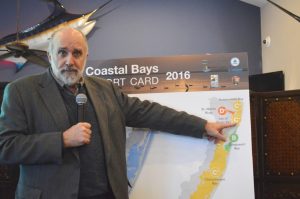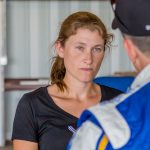
WEST OCEAN CITY – The health of Maryland’s coastal bays remained consistent last year, according to a report card released by the Maryland Coastal Bays Program (MCBP) and its partners this week.
In 2016, the coastal bay system received a C-plus in an annual report card that was unveiled at the Ocean City Marlin Club on Tuesday.
Frank Piorko, executive director of the MCBP, said the coastal bays’ grade remained the same as last year.
“We are not moving the needle terribly one year to the next,” he said. “But we made some improvements in a couple of our bays.”
Maryland’s coastal bays are graded based on reports from six regions: Assawoman, Chincoteague, Isle of Wight, Newport and Sinepuxent bays and the St. Martin River.
The rating is based off chlorophyll A, dissolved oxygen, total nitrogen, total phosphorous, seagrass and hard clam measurements taken from all six waterways.
According to the 2016 report card, improvements in Assawoman, Isle of Wight and Sinepuxent bays were offset by declines in the Chincoteague and Newport bays. The St. Martin River reported no change.
“While we have trends that cause us to be concerned, such as continued loss of beneficial seagrasses and high nutrient loading, we’ve seen improvements in hard clam populations and some other indicators in some of the bays,” Piorko said. “We are encouraged in that respect.”
Most notable changes were improved phosphorus, chlorophyll A and hard clam measurements at the Assawoman and Isle of Wight bays, both of which received a higher score than in 2015.
“We haven’t backslid on any of the indicators so far, so progress is being made,” Piorko said.
Maryland Department of Natural Resources (DNR) Secretary Mark Belton encouraged citizens and state agencies to continue their efforts to improve the coastal bay system.
“While it is improving, it’s got a long way to go,” he said. “So we’ve got to make sure to keep our nose to the grindstone.”
Dr. William Dennison, vice president for science application at the University of Maryland Center for Environmental Science (UMCES), said the 2016 report card highlights some noticeable trends in the coastal bay system.
“North of the Inlet things are getting better, but south of the Inlet not so much,” he said. “We are still seeing some signs of degradation down in Chincoteague.”
Dennison said septic systems on Chincoteague Island, streams and ditches along Chincoteague’s shore and a potential nutrient plume traveling south from Ocean City are main sources of water quality degradation in parts of the coastal bay system. He said these sources have led to lower seagrass and oxygen levels and higher microalgae levels.
Regardless, Dennison said he remains hopeful that the coastal bays will soon emulate recent water quality improvements in the Chesapeake Bay.
“We should recognize that it takes a while to run these systems down and therefore it takes a lot to bring these systems back …,” he said.
Dennison and Piorko each acknowledged local, state and federal agencies, local partnering organizations and community members for working to maintain and restore the coastal bays.
“The coastal bays are a jewel, a tiara, of the Maryland waterways,” Dennison said, “and we’ve got to recognize it for what it is.”

